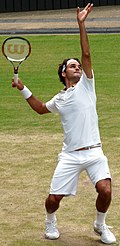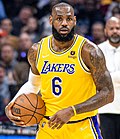List of winners
| Year of award | Image | Athlete | Nation of citizenship | Team | Competition, governing body, or league | Sport | Record set | Previous record-holder | Ref(s) |
|---|---|---|---|---|---|---|---|---|---|
| 2001 |  | Pete Sampras | — | ATP Tour | Tennis | Total career men's singles Grand Slam titles (13). This record has since been surpassed by Roger Federer. | Roy Emerson (12) | [3] [4] [5] | |
| 2002 |  | Tiger Woods | — | PGA Tour | Golf | Consecutive men's major championships won (Four—the 2000 U.S. Open, The Open Championship, and PGA Championship and the 2001 Masters Tournament [known as the consecutive Grand Slam ]) | Ben Hogan (three, in 1953) | [6] [7] | |
| 2003 |  | Emmitt Smith | Dallas Cowboys | National Football League (NFL) | American football | Total career NFL rushing yards (17,162 at the close of the league's 2002 season, with 975 tallied therein) | American Walter Payton (16,726, across the 13 seasons between 1975 and 1987, inclusive) | [8] [9] | |
| 2004 |  | Éric Gagné | Los Angeles Dodgers | Major League Baseball (MLB) | Baseball | Consecutive saves converted in a single MLB regular season (55 across the league's 2003 season) | Tom Gordon (46, in 1998) | [9] [10] | |
| 2005 |  | Peyton Manning | Indianapolis Colts | National Football League (NFL) | American football | Total single-season NFL passing touchdowns (49 in the league's 2004 season) | Dan Marino (48 in the 1984 season) | [9] [11] | |
| 2006 |  | Shaun Alexander | Seattle Seahawks | Total single-season NFL rushing touchdowns (27 in the league's 2005 season) | Priest Holmes (23, in 2003) | [12] [13] | |||
| 2007 |  | LaDainian Tomlinson | San Diego Chargers | Total single-season NFL rushing touchdowns (28 in the league's 2006 season) | Shaun Alexander (27, in 2005) | [9] ǂ [14] | |||
| 2008 |  | Brett Favre | Green Bay Packers | Total career NFL passing touchdowns (442 at the close of the 2007 season, with 28 tallied therein) | Dan Marino (420, across the 17 seasons between 1983 and 1999, inclusive) | [9] [15] | |||
| 2009 |  | Michael Phelps | — | Olympic Games | Swimming | Total gold medals achieved at a single Games of the Olympiad (eight in the 2008 Summer Olympics) | Mark Spitz (seven, at the 1972 Summer Olympics) | [16] [17] | |
| 2010 |  | John Isner vs. Nicolas Mahut | — | Wimbledon | Tennis | Longest match in tennis history, lasting 11 hours, 5 minutes; Isner defeated Mahut 70–68 in the fifth set of the 1st round match. | Fabrice Santoro vs. Arnaud Clément fourth round match at the 2004 French Open lasting 6 hours, 33 minutes. | [18] [19] | |
| 2011 |  | Rory McIlroy | — | U.S. Open | Golf | In winning the U.S. Open, McIlroy broke tournament records for the lowest 72-hole score, both in total strokes (268) and in relation to par (−16). | 72-hole score (272): Jim Furyk, 2003; Tiger Woods, 2000; Lee Janzen, 1993; Jack Nicklaus, 1980. To-par (−12): Woods, 2000. | [20] [21] | |
| 2012 |  | Drew Brees | New Orleans Saints | National Football League (NFL) | American football | Brees threw for 5,476 yards in 2011–12, breaking the NFL single-season record. | Dan Marino (5,084 yards in 1984) | [22] [23] | |
| 2013 |  | Michael Phelps (2) | — | Olympic Games | Swimming | Phelps became the most decorated Olympian in history, finishing the London Olympics with a total of 22 medals. | Larisa Latynina (19 medals, 1956–1964, representing the Soviet Union) | [17] [24] | |
| 2014 |  | Peyton Manning (2) | Denver Broncos | National Football League (NFL) | American football | Manning set single-season NFL records for both passing yardage (5,477) and touchdown passes (55) in the 2013 season. | Yardage: Drew Brees (5,476 yards in 2011) TDs: Tom Brady (50 in 2007) | [25] [26] [27] | |
| 2015 |  | Peyton Manning (3) | Manning set the NFL record for career touchdown passes (530 at the end of the 2014 season). | Brett Favre (touchdown passes 1991–2010) | [28] [29] | ||||
| 2016 |  | Stephen Curry | Golden State Warriors | National Basketball Association (NBA) | Basketball | Curry set the record for most three-point field goals in a season with 402. | Curry had the previous record, 286 in the 2014–15 season. | [30] [31] | |
| 2017 |  | Michael Phelps (3) | — | Olympic Games | Swimming | Phelps extended his own record of being the most decorated Olympian during the Rio Olympics in 2016 with a total of 28 Olympic medals. He now has 23 Gold, 3 Silver, and 2 Bronze Olympic Medals. | Phelps previously held the record when he broke it in the London 2012 Olympics where he finished with a grand total of 22 Olympic medals. | [17] [32] | |
| 2018 |  | Roger Federer | — | Wimbledon | Tennis | Most Wimbledon Gentlemen's Singles championships all time with 8 | Federer was previously tied with William Renshaw & Pete Sampras with 7 | [33] | |
| 2019 |  | Drew Brees (2) | New Orleans Saints | National Football League (NFL) | American football | Brees set the record for most passing yards (71,940) | Peyton Manning | ||
| 2020 | Not awarded due to the COVID-19 pandemic | ||||||||
| 2021 |  | Russell Westbrook | Washington Wizards | National Basketball Association (NBA) | Basketball | Westbrook set the record for most career triple-doubles (182) | Oscar Robertson (181) | [34] | |
| 2022 |  | Stephen Curry (2) | Golden State Warriors | Curry set the record for most career three-point field goals (3,117) | Ray Allen (2,973) | [35] | |||
| 2023 |  | LeBron James | Los Angeles Lakers | James set the record for most NBA career points (38,652) | Kareem Abdul-Jabbar (38,387) | [36] | |||
| 2024 |  | Caitlin Clark | Iowa Hawkeyes | National Collegiate Athletic Association (NCAA) | Clark set the record for most NCAA career points scored (men's and women's) (3,951) | Pete Maravich (3,667) | [37] | ||
| 2025 |  | Alexander Ovechkin | Washington Capitals | National Hockey League (NHL) | Ice hockey | Ovechkin set the record for most NHL career goals (895) | Wayne Gretzky (894) | [38] | |